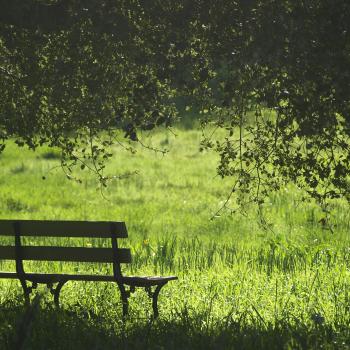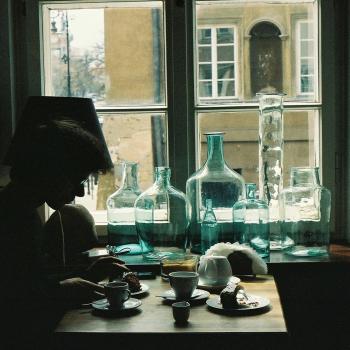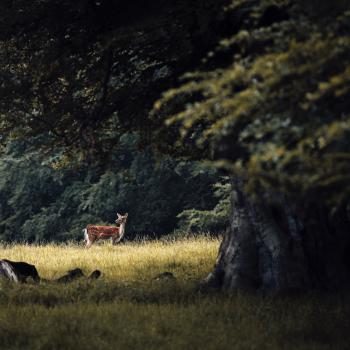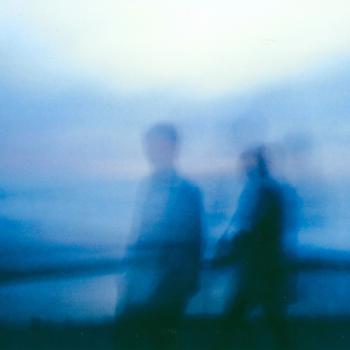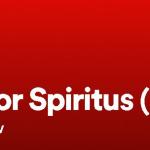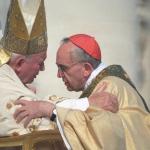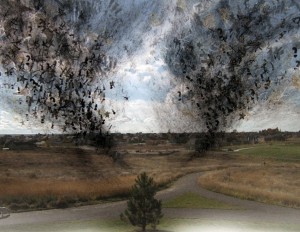 Guest post by Hunter Sharpless
Guest post by Hunter Sharpless
To celebrate Image’s twenty-fifth anniversary we are posting a series of essays by people who have encountered our programs over the years. Read the earlier installments: Stumbling into the Waterfall, Henri Nouwen, Reaching Out, The Notecards of Paradise, and 18 Years of Glen Workshops.
Once I eavesdropped on a conversation in the graduate student lounge. A couple of my MFA peers here at the University of Minnesota were discussing a project they were going to call the Post-human Anthology. A snippet of their editorial statement: “We are simply and passionately trying to assemble a constellation of visionary contemporary poetry that challenges humanism by reaching into the volatile beyonds of post-humanism.”
This is today’s avant-garde: A rational materialism so strict that it has moved beyond any distinction between human beings and animals.
Two hours later, off campus, I was with a group of friends that not only believes in the atavistic ideas of the soul and human exceptionalism, but in fact believes that we have been made in the image of a loving, omnipotent God.
Thus swings the intellectual schedule of an evangelical Texan writer.
In the morning it’s Derrida, Foucault, and Barthes. In the morning the Author is dead, God is long dead, and the vestiges of the human soul are trickling out the door.
In the afternoon it’s Calvin, Merton, and Hopkins. In the afternoon every atom is charged with the electric presence and purpose of the divine, there is a God on high whose rule is sovereign, and that same God decided to sacrifice himself for a stubborn people.
It’s jarring. It’s hard to see the gray space in between, easy to buy into the black-and-white categorizing of each worldview.
A few weeks ago as I sat in a poetry class, our teacher, Peter Campion, rambled on benevolently about something or other. In the beautiful way that only poets can, he spoke aphoristically; he digressed and wandered. Maybe talking about Robert Pinsky’s The Sounds of Poetry, maybe quoting John Berryman saying that the poet lives a “fierce and airy occupation,” maybe comparing words to poker chips.
Then, prompting us into a writing exercise, he said, “You know, often times it’s about discovering what you don’t want to write about…”
Oh God, I thought. Please no. I tried to shake off some itinerant idea forcing itself into my mind. Oh God—not taking the Lord’s name in vain, but praying. Praying, but not happy about it. Oh God, please tell me that’s not You nudging me in the side right now.
Allow me to explain. I am a naturally conservative person, not politically but artistically. I like tradition and lineages. Sometimes that bent can be a good thing—I’d like to think I know my essay history decently well—but at other times I can get legalistic. I succumb easily to black-and-white thinking.
Over the course of the last six years the one stricture by which I decided to abide was that I would not write about my faith. It just seemed too complicated.
My classical education in high school had exposed me to a number of great and courageous Christian writers—Augustine, Dostoevsky, O’Connor—but despite these models, I idolized Hemingway, Fitzgerald, and Joyce—the good old modernists who paved the way for the poststructuralists. I embraced the axioms of the school, both good and bad, both the splendid attention to mastering craft but also the rampant cynicism that often seems embedded in modernism.
So when God—or my own conscience, or whatever—rather abruptly interrupted my blank page in Peter’s class that day, I wasn’t quite prepared to enter the mysterious gray. It has been easy to see the two poles—the non-spiritual avant-garde on one end and the sappy Christian artists on the other—and to choose one. I decided on the former, because the cliquishness of militantly conservative Christians was painful. I shrouded my faith.
What I am not saying is that every Christian who is an artist must announce their faith with a smoke machine, but my decision to be a non-religious writer, my obsession with cloaking any trace of faith, was not based on a carefully contemplated calling. I had not examined myself, had not asked God what he thought.
I hid because I was afraid.
Afraid to inhabit the space between: the gray space, the space of the incarnation, the Word made flesh. For years I didn’t see—or, more accurately, didn’t seek—guides to that middle ground.
Last week the 80th issue of Image arrived in my mailbox. On the bottom right of the cover: 1989-2014. How fitting that we should be born the same year.
I opened it. I read through Gregory Wolfe’s editorial statement: “The making of art informed by religious faith is not a thing of the past but is an irrepressible human need.” Through the celebration of the magazine’s past voiced by Mary McCleary, among others: “The whole may grow into a community—a body—over time.” Through the vision of its future as seen by Casey N. Cep: “Image is a journal that has always and must continue to provide a home for good art. If art is good and beautiful and true, then surely God dwells in it, whether or not the name of God appears in its pages or within its frames.”
Alone, I am not a courageous man. I suppose if you asked a friend to say some things about Hunter Sharpless, they might compliment him here or there, but I don’t know they’d use the word courageous.
But that’s what I want to be: fierce, honest, brave. And these pages, these voices—Meis, Cep, Ramos—they give me hope.
Hunter Sharpless is an essayist, vagrant Texan, and MFA student at the University of Minnesota. His precarious social media presences can be found here and here. He is currently working with writers Ray Gonzalez and Patricia Hampl on what will be his second book, a collection of essays that mixes travel writing with historical and personal reflection. His first book, a road memoir on the band Stephen Kellogg and the Sixers, is in the submission process.
Art Pictured: Scott Kolbo. Suburbs, 2013. Archival Ink Jet. Graphite, Ink, and Charcoal.






